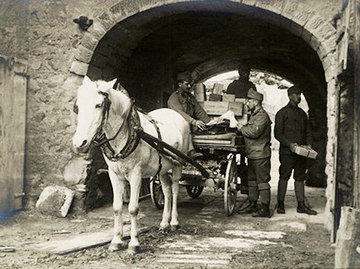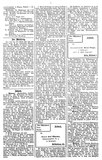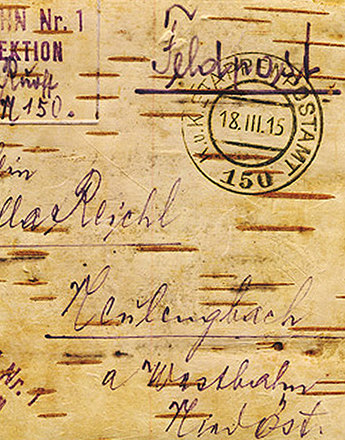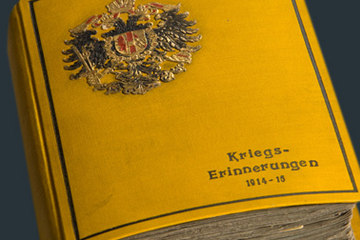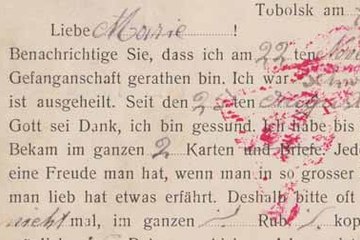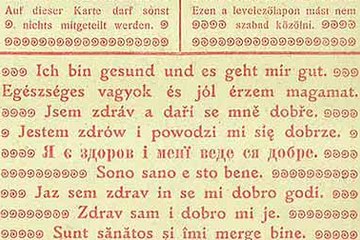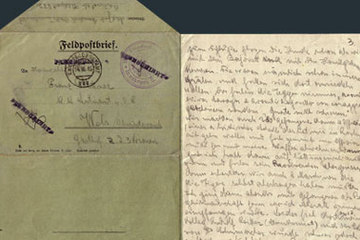How did a letter get from A to B?
Each item sent from the home front by the Imperial and Royal postal system started its journey in the Monarchy at a post office. From there it made its way to the postal collection points where post for the front was sorted according to formation and troop unit. So-called ‘travelling Feldpost collection points’, as Paul Höger has called them, even performed this operation while trains were in transit on central railway lines.
From the collection points the mail continued on its journey to the main field post offices which had mostly been set up at central locations such as for example railway junctions. After that the post was distributed to the individual field post offices of the corps and divisions as well as to the base field post offices. From there it was collected by the detachments and troops seconded for this duty. Post from the front took the reverse route.
In order to ensure the rapid and smooth despatch of mail for the front strict guidelines were laid down in the Dienstbuch E-47 rulebook concerning the labelling and addressing of the items to be sent. The name and address of the sender had to be written in the top left-hand corner, and in the top right-hand corner the inscription Feldpost (or Tabori posta in Hungarian); the addressee and address were to be written in the central field and the field or base post office at bottom right. During the first days of the war these regulations were also published in various daily newspapers and illustrated with sample letters.
The notation Feldpost or Tabori Posta was especially important for private letters and postcards from the home front as it exempted the sender from paying postage. Letters up to a weight of 100 g were postage-free as was the so-called Feldpost-Korrespondenzkarte (field service postcard; in Hungarian Tabori postai levelezölap).
Right from the beginning of the war, the Austro-Hungarian military postal service was used on a huge scale both by those who remained at home as well as soldiers at the front, as attested by the volume of mail transported between the home and military fronts between 1914 and 1918. Estimates for the Austro-Hungarian Monarchy reckon that around nine million items of mail were conveyed daily during the four years of the war. The number of field service postcards issued officially came to 655,696,314 in the Austrian half of the Monarchy. In the Hungarian half the number came to 171,622,200, giving a total of 827,318,514. Of this total 63, 681,664 items belonged to the category of the specially pre-printed ‘I am healthy and doing well’ postcards that were issued from August 1916.
Translation: Sophie Kidd
Clement, Alfred (Hrsg.): Handbuch der Feld- und Militärpost II. 1914-1918, Graz 1964
Höger, Paul: Das Post- und Telegraphenwesen im Weltkrieg, in: Gatterer, Joachim/Lukan, Walter (Red.): Studien und Dokumente zur österreichisch-ungarischen Feldpost im Ersten Weltkrieg, Bd. 1, Wien 1989, 23-54
Patka, Frederic: Auch das war die Feldpost. Episoden aus dem dienstlichen Alltag der k. u. k. Feldpost 1914-1918, in: Gatterer, Joachim/Lukan, Walter (Red.): Studien und Dokumente zur österreichisch-ungarischen Feldpost im Ersten Weltkrieg, Bd. 1, Wien 1989, 55-75
Rebhan-Glück, Ines: „Wenn wir nur glücklich wieder beisammen wären …“ Der Krieg, der Frieden und die Liebe am Beispiel der Feldpostkorrespondenz von Mathilde und Ottokar Hanzel (1917/18), Unveröffentlichte Diplomarbeit, Wien 2010
Quotes:
„So-called ‘travelling Feldpost collection points’ ... “: quoted from: Höger, Paul: Das Post- und Telegraphenwesen im Weltkrieg, in: Gatterer, Joachim/Lukan, Walter (Red.): Studien und Dokumente zur österreichisch-ungarischen Feldpost im Ersten Weltkrieg, Bd. 1, Wien 1989, 41
„Estimates for the Austro-Hungarian Monarchy …“: figures, item of mail, quoted from: Patka, Frederic: Auch das war die Feldpost. Episoden aus dem dienstlichen Alltag der k. u. k. Feldpost 1914-1918, in: Gatterer, Joachim/Lukan, Walter (Red.): Studien und Dokumente zur österreichisch-ungarischen Feldpost im Ersten Weltkrieg, Bd. 1, Wien 1989, 74
„The number of field service postcards ...“: figures, quoted from: Höger, Paul: Das Post- und Telegraphenwesen im Weltkrieg, in: Gatterer, Joachim/Lukan, Walter (Red.): Studien und Dokumente zur österreichisch-ungarischen Feldpost im Ersten Weltkrieg, Bd. 1, Wien 1989, 43
„[...] to the category of the specially pre-printed ...“: figures, I am well and doing fine postcards, quoted from: Clement, Alfred (Hrsg.): Handbuch der Feld- und Militärpost II. 1914-1918, Graz 1964, 460
-
Chapters
- Feldpost as an instrument of warfare
- How did a letter get from A to B?
- The dialogue between the front line and the home front
- ‘I am healthy and doing well.’
- The sending of ‘gifts of love’ to the front line and food parcels to the home front
- Instrumentalizing war correspondence to shape common perceptions of the war
- Women! Don’t write gloomy letters!

